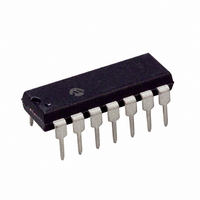PIC16F688-I/P Microchip Technology, PIC16F688-I/P Datasheet - Page 101

PIC16F688-I/P
Manufacturer Part Number
PIC16F688-I/P
Description
IC PIC MCU FLASH 4KX14 14DIP
Manufacturer
Microchip Technology
Series
PIC® 16Fr
Datasheets
1.PIC16F616T-ISL.pdf
(8 pages)
2.PIC16F688T-ISL.pdf
(204 pages)
3.PIC16F688T-ISL.pdf
(6 pages)
4.PIC16F688T-ISL.pdf
(4 pages)
5.PIC16F688T-ISL.pdf
(688 pages)
6.PIC16F688-EP.pdf
(174 pages)
Specifications of PIC16F688-I/P
Program Memory Type
FLASH
Program Memory Size
7KB (4K x 14)
Package / Case
14-DIP (0.300", 7.62mm)
Core Processor
PIC
Core Size
8-Bit
Speed
20MHz
Connectivity
UART/USART
Peripherals
Brown-out Detect/Reset, POR, WDT
Number Of I /o
12
Eeprom Size
256 x 8
Ram Size
256 x 8
Voltage - Supply (vcc/vdd)
2 V ~ 5.5 V
Data Converters
A/D 8x10b
Oscillator Type
Internal
Operating Temperature
-40°C ~ 85°C
Processor Series
PIC16F
Core
PIC
Data Bus Width
8 bit
Data Ram Size
256 B
Interface Type
SCI/USART
Maximum Clock Frequency
20 MHz
Number Of Programmable I/os
12
Number Of Timers
2
Operating Supply Voltage
2 V to 5.5 V
Maximum Operating Temperature
+ 85 C
Mounting Style
Through Hole
3rd Party Development Tools
52715-96, 52716-328, 52717-734
Development Tools By Supplier
PG164130, DV164035, DV244005, DV164005, PG164120, ICE2000, DM163014, DM164120-4
Minimum Operating Temperature
- 40 C
On-chip Adc
8-ch x 10-bit
Data Rom Size
256 B
Height
3.3 mm
Length
19.05 mm
Supply Voltage (max)
5.5 V
Supply Voltage (min)
2 V
Width
6.35 mm
Lead Free Status / RoHS Status
Lead free / RoHS Compliant
For Use With
AC162066 - HEADER INTRFC MPLAB ICD2 20PINAC162061 - HEADER INTRFC MPLAB ICD2 20PINDM163029 - BOARD PICDEM FOR MECHATRONICSAC162056 - HEADER INTERFACE ICD2 16F688ACICE0207 - MPLABICE 14P 300 MIL ADAPTERAC124001 - MODULE SKT PROMATEII 8DIP/SOIC
Lead Free Status / Rohs Status
Lead free / RoHS Compliant
Available stocks
Company
Part Number
Manufacturer
Quantity
Price
Company:
Part Number:
PIC16F688-I/P
Manufacturer:
MICROCHIP
Quantity:
26
Company:
Part Number:
PIC16F688-I/P
Manufacturer:
MOT
Quantity:
61
10.3.1
The EUSART module supports automatic detection
and calibration of the baud rate.
In the Auto-Baud Detect (ABD) mode, the clock to the
BRG is reversed. Rather than the BRG clocking the
incoming RX signal, the RX signal is timing the BRG.
The Baud Rate Generator is used to time the period of
a received 55h (ASCII “U”) which is the Sync character
for the LIN bus. The unique feature of this character is
that it has five rising edges including the Stop bit edge.
Setting the ABDEN bit of the BAUDCTL register starts
the auto-boot sequence (Figure 10-6). While the ABD
sequence takes place, the EUSART state machine is
held in Idle. On the first rising edge of the receive line,
after the Start bit, the SPBRG begins counting up using
the BRG counter clock as shown in Table 10-6. The
fifth rising edge will occur on the RX pin at the end of
the eighth bit period. At that time, an accumulated
value totaling the proper BRG period is left in
SPBRGH, SPBRG register pair, the ABDEN bit is
automatically cleared and the RCIF interrupt flag is set.
The value in the RCREG needs to be read to clear the
RCIF interrupt. RCREG content should be discarded.
When calibrating for modes that do not use the
SPBRGH register the user can verify that the SPBRG
register did not overflow by checking for 00h in the
SPBRGH register.
The BRG auto-baud clock is determined by the BRG16
and BRGH bits as shown in Table 10-6. During ABD,
both the SPBRGH and SPBRG registers are used as a
16-bit counter, independent of the BRG16 bit setting.
While calibrating the baud rate period, the SPBRGH
FIGURE 10-6:
© 2009 Microchip Technology Inc.
BRG Value
BRG Clock
ABDEN bit
RCIF bit
(Interrupt)
SPBRGH
RCREG
SPBRG
RX pin
RCIDL
Note 1:
Read
AUTO-BAUD DETECT
Set by User
The ABD sequence requires the EUSART module to be configured in Asynchronous mode.
XXXXh
AUTOMATIC BAUD RATE CALCULATION
0000h
Start
bit 0
XXh
XXh
Edge #1
bit 1
bit 2
Edge #2
and SPBRG registers are clocked at 1/8th the BRG
base clock rate. The resulting byte measurement is the
average bit time when clocked at full speed.
TABLE 10-6:
BRG16
Note:
Note 1: If the WUE bit is set with the ABDEN bit,
bit 3
0
0
1
1
2: It is up to the user to determine that the
3: During the auto-baud process, the auto-
bit 4
Edge #3
BRGH
During the ABD sequence, SPBRG and
SPBRGH registers are both used as a 16-bit
counter, independent of BRG16 setting.
auto-baud detection will occur on the byte
following the Break character (see
Section 10.3.3
Break”).
incoming character baud rate is within the
range of the selected BRG clock source.
Some combinations of oscillator frequency
and EUSART baud rates are not possible
due to bit error rates. Overall system timing
and communication baud rates must be
taken into consideration when using the
Auto-Baud Detect feature.
baud counter starts counting at 1. Upon
completion of the auto-baud sequence, to
achieve maximum accuracy, subtract 1
from the SPBRGH:SPBRG register pair.
0
1
0
1
bit 5
BRG COUNTER CLOCK RATES
BRG Base
bit 6
Edge #4
F
F
F
F
Clock
OSC
OSC
OSC
OSC
PIC16F688
bit 7
/64
/16
/16
/4
“Auto-Wake-up
Stop bit
Edge #5
DS41203E-page 99
Auto Cleared
BRG ABD
001Ch
F
F
F
F
1Ch
00h
OSC
OSC
OSC
Clock
OSC
/512
/128
/128
/32
on















